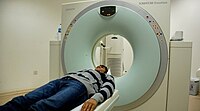
Photo from wikipedia
WHAT IS THIS SUMMARY ABOUT? This summary describes the research carried out by the United States Preventive Services Task Force (USPSTF for short) during a review and update of their… Click to show full abstract
WHAT IS THIS SUMMARY ABOUT? This summary describes the research carried out by the United States Preventive Services Task Force (USPSTF for short) during a review and update of their lung cancer screening recommendations made in 2013. The USPSTF reviewed the results of clinical studies that used a type of scan called low dose computed tomography (LDCT for short). They wanted to see how successful LDCT was at finding lung cancers in people ho hadn't shown any physical signs of lung cancer, but had a history of smoking and were over 50 years of age. WHAT WERE THE RESULTS? The review found that performing yearly LDCT scans in people who are at high risk of developing lung cancer is beneficial, as it means that some patients will be diagnosed earlier than they would be without this type of screening. People considered to be at high risk of developing lung cancer include: Adults aged 50 to 80 years who have smoked a pack of 20 cigarettes per day for 20 years or two packs per day for 10 years; OR Adults aged 50 to 80 years who currently smoke or have stopped smoking within the last 15 years. WHAT DO THE RESULTS OF THE STUDY MEAN? The information gained from reviewing the research enabled the USPSTF to update their lung cancer screening recommendations.
Journal Title: Future oncology
Year Published: 2023
Link to full text (if available)
Share on Social Media: Sign Up to like & get
recommendations!